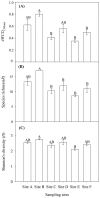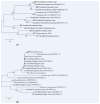Sediment enzyme activities and microbial community diversity in an oligotrophic drinking water reservoir, eastern China
- PMID: 24205265
- PMCID: PMC3808301
- DOI: 10.1371/journal.pone.0078571
Sediment enzyme activities and microbial community diversity in an oligotrophic drinking water reservoir, eastern China
Abstract
Drinking water reservoir plays a vital role in the security of urban water supply, yet little is known about microbial community diversity harbored in the sediment of this oligotrophic freshwater environmental ecosystem. In the present study, integrating community level physiological profiles (CLPPs), nested polymerase chain reaction (PCR)-denaturing gradient gel electrophoresis (DGGE) and clone sequence technologies, we examined the sediment urease and protease activities, bacterial community functional diversity, genetic diversity of bacterial and fungal communities in sediments from six sampling sites of Zhou cun drinking water reservoir, eastern China. The results showed that sediment urease activity was markedly distinct along the sites, ranged from 2.48 to 11.81 mg NH₃-N/(g·24 h). The highest average well color development (AWCD) was found in site C, indicating the highest metabolic activity of heterotrophic bacterial community. Principal component analysis (PCA) revealed tremendous differences in the functional (metabolic) diversity patterns of the sediment bacterial communities from different sites. Meanwhile, DGGE fingerprints also indicated spatial changes of genetic diversity of sediment bacterial and fungal communities. The sequence BLAST analysis of all the sediment samples found that Comamonas sp. was the dominant bacterial species harbored in site A. Alternaria alternate, Allomyces macrogynus and Rhizophydium sp. were most commonly detected fungal species in sediments of the Zhou cun drinking water reservoir. The results from this work provide new insights about the heterogeneity of sediment microbial community metabolic activity and genetic diversity in the oligotrophic drinking water reservoir.
Conflict of interest statement
Figures






Similar articles
-
Ignored sediment fungal populations in water supply reservoirs are revealed by quantitative PCR and 454 pyrosequencing.BMC Microbiol. 2015 Feb 22;15:44. doi: 10.1186/s12866-015-0379-7. BMC Microbiol. 2015. PMID: 25886005 Free PMC article.
-
Abundance and diversity of sulfate-reducing bacteria in the sediment of the Zhou Cun drinking water reservoir in Eastern China.Genet Mol Res. 2015 May 29;14(2):5830-44. doi: 10.4238/2015.May.29.15. Genet Mol Res. 2015. PMID: 26125782
-
Spatiotemporal variation of bacterial and archaeal communities in sediments of a drinking reservoir, Beijing, China.Appl Microbiol Biotechnol. 2017 Apr;101(8):3379-3391. doi: 10.1007/s00253-016-8019-1. Epub 2016 Dec 10. Appl Microbiol Biotechnol. 2017. PMID: 27942905
-
Microbial Community Composition and Extracellular Enzyme Activities Associated with Juncus roemerianus and Spartina alterniflora Vegetated Sediments in Louisiana Saltmarshes.Microb Ecol. 2016 Feb;71(2):290-303. doi: 10.1007/s00248-015-0651-2. Epub 2015 Aug 14. Microb Ecol. 2016. PMID: 26271740
-
Characteristics, Biodiversity, and Cultivation Strategy of Low Nucleic Acid Content Bacteria.Front Microbiol. 2022 Jun 15;13:900669. doi: 10.3389/fmicb.2022.900669. eCollection 2022. Front Microbiol. 2022. PMID: 35783413 Free PMC article. Review.
Cited by
-
Metagenomic analysis of drinking water samples collected from treatment plants of Hyderabad City and Mehran University Employees Cooperative Housing Society.Environ Sci Pollut Res Int. 2019 Oct;26(28):29052-29064. doi: 10.1007/s11356-019-05859-8. Epub 2019 Aug 7. Environ Sci Pollut Res Int. 2019. PMID: 31392612
-
Ignored sediment fungal populations in water supply reservoirs are revealed by quantitative PCR and 454 pyrosequencing.BMC Microbiol. 2015 Feb 22;15:44. doi: 10.1186/s12866-015-0379-7. BMC Microbiol. 2015. PMID: 25886005 Free PMC article.
-
New and interesting species of Penicillium (Eurotiomycetes, Aspergillaceae) in freshwater sediments from Spain.MycoKeys. 2022 Feb 1;86:103-145. doi: 10.3897/mycokeys.86.73861. eCollection 2022. MycoKeys. 2022. PMID: 35145339 Free PMC article.
-
Abundance and diversity of bacteria in oxygen minimum drinking water reservoir sediments studied by quantitative PCR and pyrosequencing.Microb Ecol. 2015 Apr;69(3):618-29. doi: 10.1007/s00248-014-0539-6. Epub 2014 Dec 13. Microb Ecol. 2015. PMID: 25502074
-
Vertical Distribution of Bacterial Community Diversity and Water Quality during the Reservoir Thermal Stratification.Int J Environ Res Public Health. 2015 Jun 17;12(6):6933-45. doi: 10.3390/ijerph120606933. Int J Environ Res Public Health. 2015. PMID: 26090607 Free PMC article.
References
-
- Holmer M, Storkholm P (2001) Sulphate reduction and sulphur cycling in lake sediments: a review. Freshw Biol 46: 431-451. doi:10.1046/j.1365-2427.2001.00687.x. - DOI
-
- Wu YC, Xiang Y, Wang JJ, Wu QL (2012) Molecular detection of novel Anammox bacterial clusters in the sediments of the shallow freshwater Lake Taihu. Geomicrobiol J 29: 852-859. doi:10.1080/01490451.2011.635760. - DOI
-
- Huang LD, Du ST, Fan L, Lin XY, Wang HL et al. (2011) Microbial activity facilitates phosphorus adsorption to shallow lake sediment. J Soils Sediment 11: 185-193. doi:10.1007/s11368-010-0305-4. - DOI
Publication types
MeSH terms
Substances
LinkOut - more resources
Full Text Sources
Other Literature Sources
Medical
Research Materials

